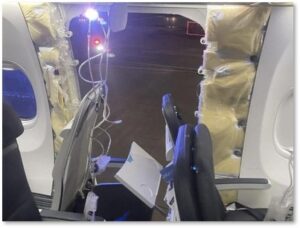I was in the pool on Saturday when two friends in the next lane were talking about whether regulations were really needed or whether companies would, on their own, do the right thing. It made me laugh.
Zombie Myths and Regulations
 Back in 2019, I wrote a post called, “Self-Regulation: The Zombie Myth That Kills.” Using historical examples, I showed that we often have a choice between the idea that regulations kill jobs (and are thus to be avoided) and that regulations save lives (and are thus necessary).
Back in 2019, I wrote a post called, “Self-Regulation: The Zombie Myth That Kills.” Using historical examples, I showed that we often have a choice between the idea that regulations kill jobs (and are thus to be avoided) and that regulations save lives (and are thus necessary).
This conflict made headlines again recently when a “plug” door came off a Boeing 737 Max 9 in mid-air as it was gaining altitude. I have read articles since that tried to explain what happened at Boeing and how this accident—only the latest in a chain of airline accidents—could have taken place. Boeing, after all, had over time earned a reputation for safety.
That has disappeared.
Lost in the Shuffle
In a guest essay in the New York Times, writer Bill Saporito faulted a series of M&A activity, capped by Boeing’s acquisition of McDonnell-Douglas.
“What got lost in all this shuffling is a corporate culture that once prized engineering and safety, replaced by one that seemed to be more focused on delivering profits over perfection. The Boeing community in Seattle has been vocal about attributing this slide to the acquisition of McDonnell Douglas, whose leaders took over Boeing’s top jobs and reshaped the culture around cost control.”
My aquatic fiends were wondering whether profits had been put above safety at Boeing. I laughed again. “Profits always come first,” I said.
The Long, Cold Fall to Earth
 Unfortunately, that statement explains why companies want regulations to go away. No regulations = more profit. Unfortunately, a lack of regulations often equals more deaths, as I demonstrated in another post, this one from 2013. “Offshoring the Garment Industry Into the Past” showed how American clothing companies took advantage of cheap labor in other countries that lack regulations to protect workers. The predictable result? Dead workers.
Unfortunately, that statement explains why companies want regulations to go away. No regulations = more profit. Unfortunately, a lack of regulations often equals more deaths, as I demonstrated in another post, this one from 2013. “Offshoring the Garment Industry Into the Past” showed how American clothing companies took advantage of cheap labor in other countries that lack regulations to protect workers. The predictable result? Dead workers.
Fortunately, the Boeing Max 9 accident happened at 16,000 feet. At that altitude, the pilot could manage cabin pressure and land the plane safely. Had the plug door blown out at a cruising altitude of 30,000 feet, everyone on the plane would have died. Some, sucked out of their seats, would have made the long, cold fall to earth before they knew what had happened. (That picture really creeps me out.)
The Post-Damage Scramble
Now, once again, a company scrambles after the fact to fix the problem, to undo the damage, to recover its reputation. Somehow, companies find this damage control more cost-effective and thus preferable to doing a good job in the first place. Had that plane gone down, they would have faced fines, settlements, and damages in the gazillions.
But, hey, they were just playing the odds, right?
The Cost of Regulations
 Somewhere in the Accounting Department, loyal employees calculate the cost of a human life so the guys in Mahogany Row can decide how many lives they can risk instead of having to redesign a fuselage, replace a bolt, or slow down the turn-around time. It’s a grim and cynical equation in which human life becomes just another factor to juggle.
Somewhere in the Accounting Department, loyal employees calculate the cost of a human life so the guys in Mahogany Row can decide how many lives they can risk instead of having to redesign a fuselage, replace a bolt, or slow down the turn-around time. It’s a grim and cynical equation in which human life becomes just another factor to juggle.
It’s also what happens when a company loses sight of its responsibilities to employees, customers and the community. Or, worse, when it deliberately abandons those responsibilities to raise the stock price and increase those all-important executive bonuses.
What can we, as customers, do? We can ask ourselves which is worse: job-killing regulations or people-killing accidents. Make up your mind and vote accordingly.
